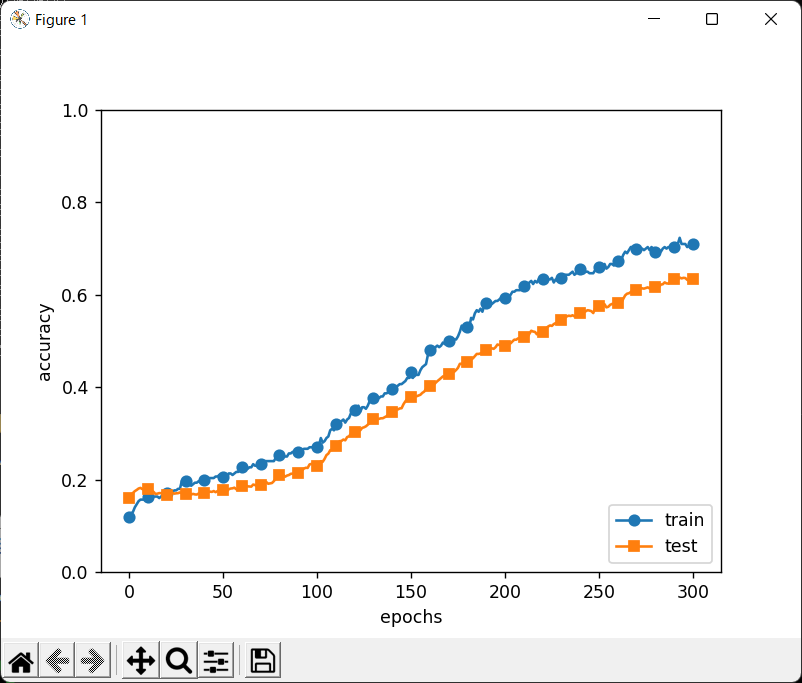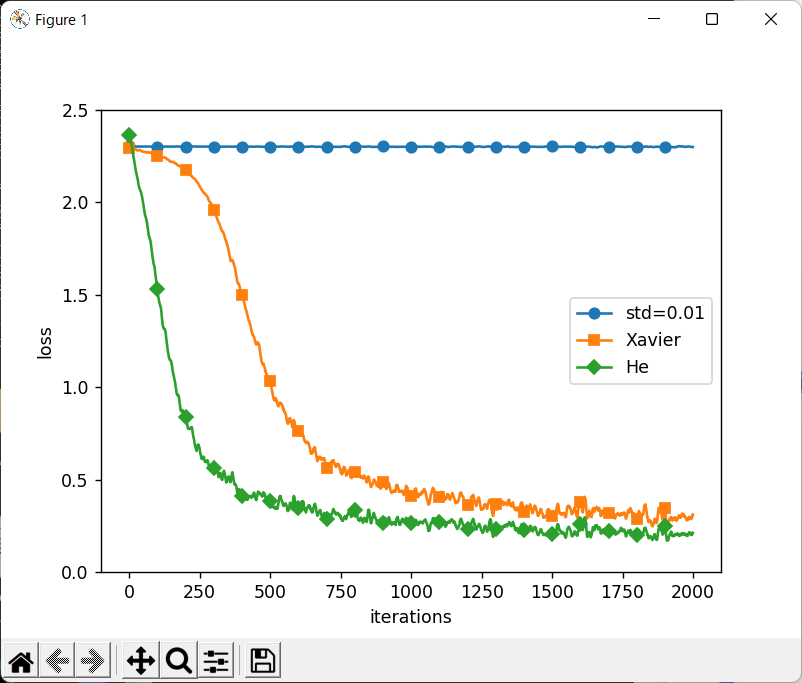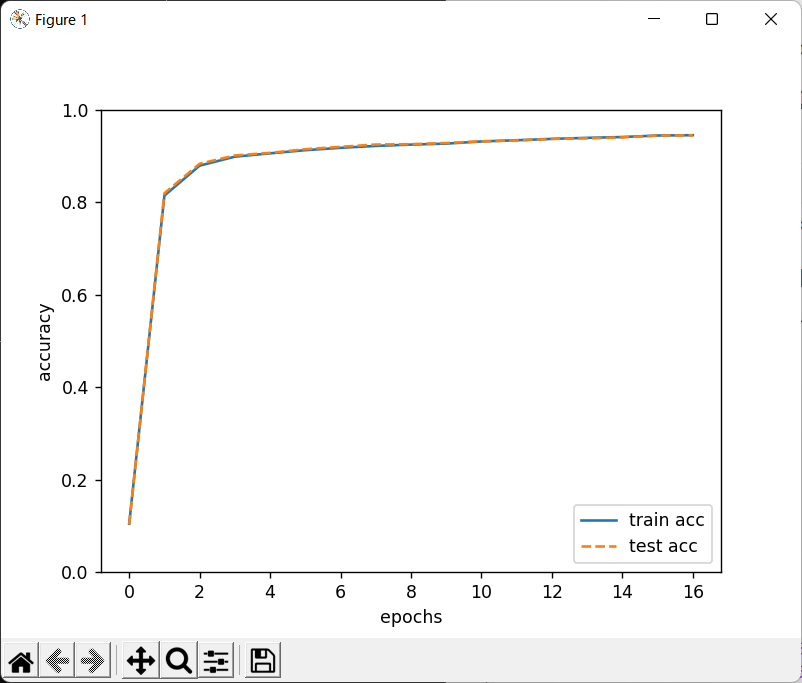deep-learning-from-scratch/ch06 at master · oreilly-japan/deep-learning-from-scratch · GitHub
「ゼロから作るDeep Learning ① (Pythonで学ぶディープラーニングの理論と実装)」 p.197~202 の写経です。
ハイパーパラメータとは?
- 各層のニューロン数
- バッチサイズ
- パラメータの更新の際の学習係数
- Weight decay
等で、重みやバイアスとは別
検証データ (≠テストデータ)
テストデータを使ってハイパーパラメータを調整すると、 ハイパーパラメータの値はテストデータに対し過学習する。
ハイパーパラメータの調整には、 ハイパーパラメータ専用の検証データが必要らしい。
ハイパーパラメータ最適化のpython実装
# coding: utf-8 import sys, os import numpy as np import matplotlib.pyplot as plt import urllib.request import gzip from collections import OrderedDict def main(): mymnist = MyMnist() (x_train, t_train, x_test, t_test) = mymnist.load_mnist() # 高速化の為、訓練data削減 x_train = x_train[:500] t_train = t_train[:500] # 検証data分離 validation_rate = 0.20 validation_num = int(x_train.shape[0] * validation_rate) x_train, t_train = shuffle_dataset(x_train, t_train) x_val = x_train[:validation_num] # 検証data t_val = t_train[:validation_num] # 〃 x_train = x_train[validation_num:] t_train = t_train[validation_num:] # ハイパーパラメータのランダム探索 optimization_trial = 100 results_val = {} results_train = {} for _ in range(optimization_trial): # 探索したハイパーパラメータの範囲を指定 weight_decay = 10 ** np.random.uniform(-8, -4) lr = 10 ** np.random.uniform(-6, -2) # 学習係数 val_acc_list, train_acc_list = __train(lr, weight_decay, x_train, t_train, x_val, t_val ) print("val acc:", str(val_acc_list[-1]), " | lr:" + str(lr), "weight decay:", str(weight_decay) ) key = "lr:" + str(lr) + ", weight decay:" + str(weight_decay) results_val[key] = val_acc_list results_train[key] = train_acc_list # グラフの描画 graph_draw_num = 20 col_num = 5 row_num = int(np.ceil(graph_draw_num / col_num)) i = 0 for key, val_acc_list in sorted(results_val.items(), key=lambda x:x[1][-1], reverse=True): print("Best-" + str(i+1), "(val acc:" + str(val_acc_list[-1]) + ") | " + key) plt.subplot(row_num, col_num, i+1) plt.title("Best-" + str(i+1)) plt.ylim(0.0, 1.0) if i % 5: plt.yticks([]) plt.xticks([]) x = np.arange(len(val_acc_list)) plt.plot(x, val_acc_list) plt.plot(x, results_train[key], "--") i += 1 if i >= graph_draw_num: break plt.show() def __train(lr, weight_decay, x_train, t_train, x_val, t_val, epocs=50): network = MultiLayerNet(input_size=784, hidden_size_list=[100, 100, 100, 100, 100, 100], output_size=10, weight_decay_lambda=weight_decay) trainer = Trainer(network, x_train, t_train, x_val, t_val, epochs=epocs, mini_batch_size=100, optimizer='sgd', optimizer_param={'lr': lr}, verbose=False) trainer.train() return trainer.test_acc_list, trainer.train_acc_list class MyMnist: def __init__(self): pass def load_mnist(self): data_files = self.download_mnist() # convert numpy dataset = {} dataset['train_img'] = self.load_img( data_files['train_img'] ) dataset['train_label'] = self.load_label(data_files['train_label']) dataset['test_img'] = self.load_img( data_files['test_img'] ) dataset['test_label'] = self.load_label(data_files['test_label']) for key in ('train_img', 'test_img'): dataset[key] = dataset[key].astype(np.float32) dataset[key] /= 255.0 for key in ('train_label','test_label'): dataset[key]=self.change_one_hot_label( dataset[key] ) return (dataset['train_img'], dataset['train_label'], dataset['test_img'], dataset['test_label'] ) def change_one_hot_label(self,X): T = np.zeros((X.size, 10)) for idx, row in enumerate(T): row[X[idx]] = 1 return T def download_mnist(self): url_base = 'http://yann.lecun.com/exdb/mnist/' key_file = {'train_img' :'train-images-idx3-ubyte.gz', 'train_label':'train-labels-idx1-ubyte.gz', 'test_img' :'t10k-images-idx3-ubyte.gz', 'test_label' :'t10k-labels-idx1-ubyte.gz' } data_files = {} dataset_dir = os.path.dirname(os.path.abspath(__file__)) for data_name, file_name in key_file.items(): req_url = url_base+file_name file_path = dataset_dir + "/" + file_name request = urllib.request.Request( req_url ) response = urllib.request.urlopen(request).read() with open(file_path, mode='wb') as f: f.write(response) data_files[data_name] = file_path return data_files def load_img( self,file_path): img_size = 784 # = 28*28 with gzip.open(file_path, 'rb') as f: data = np.frombuffer(f.read(), np.uint8, offset=16) data = data.reshape(-1, img_size) return data def load_label(self,file_path): with gzip.open(file_path, 'rb') as f: labels = np.frombuffer(f.read(), np.uint8, offset=8) return labels # x:訓練データ、t:教師データ def shuffle_dataset(x, t): permutation = np.random.permutation(x.shape[0]) x = x[permutation,:] if x.ndim == 2 else x[permutation,:,:,:] t = t[permutation] return x, t # 全結合による多層ニューラルネットワーク class MultiLayerNet: """ input_size : hidden_size_list : 隠れ層のニューロンの数のリスト(e.g. [100, 100, 100]) output_size : activation : 'relu' or 'sigmoid' weight_init_std : 重みの標準偏差を指定(e.g. 0.01) 'relu'または'he'を指定した場合は「Heの初期値」を設定 'sigmoid'または'xavier'を指定した場合は「Xavierの初期値」を設定 weight_decay_lambda : Weight Decay(L2ノルム)の強さ """ def __init__(self, input_size, # 入力size(MNISTの場合 784) hidden_size_list,# 隠れ層neuron数list 例[100,100,100] output_size, # 出力size(MNISTの場合は10) activation='relu', # 活性化関数 'relu' or 'sigmoid' weight_init_std='relu', weight_decay_lambda=0): self.input_size = input_size self.output_size = output_size self.hidden_size_list = hidden_size_list self.hidden_layer_num = len(hidden_size_list) self.weight_decay_lambda = weight_decay_lambda self.params = {} # 重みの初期化 self.__init_weight(weight_init_std) # レイヤの生成 activation_layer = {'sigmoid': Sigmoid, 'relu': Relu} self.layers = OrderedDict() for idx in range(1, self.hidden_layer_num+1): self.layers['Affine' + str(idx)] = Affine(self.params['W' + str(idx)], self.params['b' + str(idx)]) self.layers['Activation_function' + str(idx)] = activation_layer[activation]() idx = self.hidden_layer_num + 1 self.layers['Affine' + str(idx)] = Affine(self.params['W' + str(idx)], self.params['b' + str(idx)]) self.last_layer = SoftmaxWithLoss() def __init_weight(self, weight_init_std): """重みの初期値設定 Parameters ---------- weight_init_std : 重みの標準偏差を指定(e.g. 0.01) 'relu'または'he'を指定した場合は「Heの初期値」を設定 'sigmoid'または'xavier'を指定した場合は「Xavierの初期値」を設定 """ all_size_list = [self.input_size] + self.hidden_size_list + [self.output_size] for idx in range(1, len(all_size_list)): scale = weight_init_std if str(weight_init_std).lower() in ('relu', 'he'): scale = np.sqrt(2.0 / all_size_list[idx - 1]) # ReLUを使う場合に推奨される初期値 elif str(weight_init_std).lower() in ('sigmoid', 'xavier'): scale = np.sqrt(1.0 / all_size_list[idx - 1]) # sigmoidを使う場合に推奨される初期値 self.params['W' + str(idx)] = scale * np.random.randn(all_size_list[idx-1], all_size_list[idx]) self.params['b' + str(idx)] = np.zeros(all_size_list[idx]) def predict(self, x): for layer in self.layers.values(): x = layer.forward(x) return x def loss(self, x, t): """損失関数を求める Parameters ---------- x : 入力データ t : 教師ラベル Returns ------- 損失関数の値 """ y = self.predict(x) weight_decay = 0 for idx in range(1, self.hidden_layer_num + 2): W = self.params['W' + str(idx)] weight_decay += 0.5 * self.weight_decay_lambda * np.sum(W ** 2) return self.last_layer.forward(y, t) + weight_decay def accuracy(self, x, t): y = self.predict(x) y = np.argmax(y, axis=1) if t.ndim != 1 : t = np.argmax(t, axis=1) accuracy = np.sum(y == t) / float(x.shape[0]) return accuracy def numerical_gradient(self, x, t): """勾配を求める(数値微分) Parameters ---------- x : 入力データ t : 教師ラベル Returns ------- 各層の勾配を持ったディクショナリ変数 grads['W1']、grads['W2']、...は各層の重み grads['b1']、grads['b2']、...は各層のバイアス """ loss_W = lambda W: self.loss(x, t) grads = {} for idx in range(1, self.hidden_layer_num+2): grads['W' + str(idx)] = numerical_gradient(loss_W, self.params['W' + str(idx)]) grads['b' + str(idx)] = numerical_gradient(loss_W, self.params['b' + str(idx)]) return grads def gradient(self, x, t): """勾配を求める(誤差逆伝搬法) Parameters ---------- x : 入力データ t : 教師ラベル Returns ------- 各層の勾配を持ったディクショナリ変数 grads['W1']、grads['W2']、...は各層の重み grads['b1']、grads['b2']、...は各層のバイアス """ # forward self.loss(x, t) # backward dout = 1 dout = self.last_layer.backward(dout) layers = list(self.layers.values()) layers.reverse() for layer in layers: dout = layer.backward(dout) # 設定 grads = {} for idx in range(1, self.hidden_layer_num+2): grads['W' + str(idx)] = self.layers['Affine' + str(idx)].dW + self.weight_decay_lambda * self.layers['Affine' + str(idx)].W grads['b' + str(idx)] = self.layers['Affine' + str(idx)].db return grads class Relu: def __init__(self): self.mask = None def forward(self, x): self.mask = (x <= 0) out = x.copy() out[self.mask] = 0 return out def backward(self, dout): dout[self.mask] = 0 dx = dout return dx class Sigmoid: def __init__(self): self.out = None def forward(self, x): out = sigmoid(x) self.out = out return out def backward(self, dout): dx = dout * (1.0 - self.out) * self.out return dx class Affine: def __init__(self, W, b): self.W =W self.b = b self.x = None self.original_x_shape = None # 重み・バイアスパラメータの微分 self.dW = None self.db = None def forward(self, x): # テンソル対応 self.original_x_shape = x.shape x = x.reshape(x.shape[0], -1) self.x = x out = np.dot(self.x, self.W) + self.b return out def backward(self, dout): dx = np.dot(dout, self.W.T) self.dW = np.dot(self.x.T, dout) self.db = np.sum(dout, axis=0) dx = dx.reshape(*self.original_x_shape) return dx class SoftmaxWithLoss: def __init__(self): self.loss = None self.y = None # softmaxの出力 self.t = None # 教師データ def forward(self, x, t): self.t = t self.y = self.softmax(x) self.loss = self.cross_entropy_error(self.y, self.t) return self.loss def backward(self, dout=1): batch_size = self.t.shape[0] if self.t.size == self.y.size: # 教師データがone-hot-vectorの場合 dx = (self.y - self.t) / batch_size else: dx = self.y.copy() dx[np.arange(batch_size), self.t] -= 1 dx = dx / batch_size return dx def softmax(self,x): x = x - np.max(x, axis=-1, keepdims=True) # オーバーフロー対策 return np.exp(x) / np.sum(np.exp(x), axis=-1, keepdims=True) def cross_entropy_error(self, y, t): if y.ndim == 1: t = t.reshape(1, t.size) y = y.reshape(1, y.size) # 教師データがone-hot-vectorの場合、正解ラベルのインデックスに変換 if t.size == y.size: t = t.argmax(axis=1) batch_size = y.shape[0] return -np.sum(np.log(y[np.arange(batch_size), t] + 1e-7)) / batch_size class Trainer: def __init__(self, network, x_train, t_train, x_test, t_test, epochs=20, mini_batch_size=100, optimizer='SGD', optimizer_param={'lr':0.01}, evaluate_sample_num_per_epoch=None, verbose=True): self.network = network self.verbose = verbose self.x_train = x_train self.t_train = t_train self.x_test = x_test self.t_test = t_test self.epochs = epochs self.batch_size = mini_batch_size self.evaluate_sample_num_per_epoch = evaluate_sample_num_per_epoch # optimizer optimizer_class_dict = {'sgd' :SGD, 'momentum':Momentum, 'nesterov':Nesterov, 'adagrad' :AdaGrad, 'rmsprop' :RMSprop, 'adam' :Adam} self.optimizer = optimizer_class_dict[optimizer.lower()](**optimizer_param) self.train_size = x_train.shape[0] self.iter_per_epoch = max(self.train_size / mini_batch_size, 1) self.max_iter = int(epochs * self.iter_per_epoch) self.current_iter = 0 self.current_epoch = 0 self.train_loss_list = [] self.train_acc_list = [] self.test_acc_list = [] def train_step(self): batch_mask = np.random.choice(self.train_size, self.batch_size) x_batch = self.x_train[batch_mask] t_batch = self.t_train[batch_mask] grads = self.network.gradient(x_batch, t_batch) self.optimizer.update(self.network.params, grads) loss = self.network.loss(x_batch, t_batch) self.train_loss_list.append(loss) if self.verbose: print("train loss:" + str(loss)) if self.current_iter % self.iter_per_epoch == 0: self.current_epoch += 1 x_train_sample, t_train_sample = self.x_train, self.t_train x_test_sample, t_test_sample = self.x_test, self.t_test if not self.evaluate_sample_num_per_epoch is None: t = self.evaluate_sample_num_per_epoch x_train_sample, t_train_sample = self.x_train[:t], self.t_train[:t] x_test_sample, t_test_sample = self.x_test[:t], self.t_test[:t] train_acc = self.network.accuracy(x_train_sample, t_train_sample) test_acc = self.network.accuracy(x_test_sample, t_test_sample) self.train_acc_list.append(train_acc) self.test_acc_list.append(test_acc) if self.verbose: print("epoch:",str(self.current_epoch), "train acc:",str(train_acc), "test acc:", str(test_acc) ) self.current_iter += 1 def train(self): for i in range(self.max_iter): self.train_step() test_acc = self.network.accuracy(self.x_test, self.t_test) if self.verbose: print("=============== Final Test Accuracy ===============") print("test acc:" + str(test_acc)) # 確率的勾配降下法(Stochastic Gradient Descent) class SGD: def __init__(self, lr=0.01): self.lr = lr def update(self, params, grads): for key in params.keys(): params[key] -= self.lr * grads[key] class Momentum: def __init__(self, lr=0.01, momentum=0.9): self.lr = lr self.momentum = momentum self.v = None def update(self, params, grads): if self.v is None: self.v = {} for key, val in params.items(): self.v[key] = np.zeros_like(val) for key in params.keys(): self.v[key] = self.momentum*self.v[key] - self.lr*grads[key] params[key] += self.v[key] # Nesterov's Accelerated Gradient http://arxiv.org/abs/1212.0901 class Nesterov: def __init__(self, lr=0.01, momentum=0.9): self.lr = lr self.momentum = momentum self.v = None def update(self, params, grads): if self.v is None: self.v = {} for key, val in params.items(): self.v[key] = np.zeros_like(val) for key in params.keys(): params[key] += self.momentum * self.momentum * self.v[key] params[key] -= (1 + self.momentum) * self.lr * grads[key] self.v[key] *= self.momentum self.v[key] -= self.lr * grads[key] class AdaGrad: def __init__(self, lr=0.01): self.lr = lr self.h = None def update(self, params, grads): if self.h is None: self.h = {} for key, val in params.items(): self.h[key] = np.zeros_like(val) for key in params.keys(): self.h[key] += grads[key] * grads[key] params[key] -= self.lr * grads[key] / (np.sqrt(self.h[key]) + 1e-7) class RMSprop: def __init__(self, lr=0.01, decay_rate = 0.99): self.lr = lr self.decay_rate = decay_rate self.h = None def update(self, params, grads): if self.h is None: self.h = {} for key, val in params.items(): self.h[key] = np.zeros_like(val) for key in params.keys(): self.h[key] *= self.decay_rate self.h[key] += (1 - self.decay_rate) * grads[key] * grads[key] params[key] -= self.lr * grads[key] / (np.sqrt(self.h[key]) + 1e-7) class Adam: # http://arxiv.org/abs/1412.6980v8 def __init__(self, lr=0.001, beta1=0.9, beta2=0.999): self.lr = lr self.beta1 = beta1 self.beta2 = beta2 self.iter = 0 self.m = None self.v = None def update(self, params, grads): if self.m is None: self.m, self.v = {}, {} for key, val in params.items(): self.m[key] = np.zeros_like(val) self.v[key] = np.zeros_like(val) self.iter += 1 lr_t = self.lr * np.sqrt(1.0 - self.beta2**self.iter) / \ (1.0 - self.beta1**self.iter) for key in params.keys(): #self.m[key] = self.beta1*self.m[key] + (1-self.beta1)*grads[key] #self.v[key] = self.beta2*self.v[key] + (1-self.beta2)*(grads[key]**2) self.m[key] += (1 - self.beta1) * (grads[key] - self.m[key]) self.v[key] += (1 - self.beta2) * (grads[key]**2 - self.v[key]) params[key] -= lr_t * self.m[key] / (np.sqrt(self.v[key]) + 1e-7) #unbias_m += (1 - self.beta1) * (grads[key] - self.m[key]) # correct bias #unbisa_b += (1 - self.beta2) * (grads[key]*grads[key] - self.v[key]) # correct bias #params[key] += self.lr * unbias_m / (np.sqrt(unbisa_b) + 1e-7) if __name__ == '__main__': main()
↑こう書くと、↓こう表示されますが、自身の理解度はイマイチです








